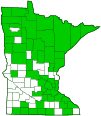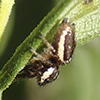bronze jumping spider
(Eris militaris)
Conservation • Description • Habitat • Biology • Distribution • Taxonomy
Conservation Status |
|
|||||||
| IUCN Red List | not listed |
|||||||
| NatureServe | NNR - Unranked SNR - Unranked |
|||||||
| Minnesota | not listed |
|||||||
Description |
||
Bronze jumping spider is a small to medium-sized brown jumping spider. It occurs across North America from Quebec and Alaska to Florida and Mexico, and in Central America. It is common in Minnesota. The male is 3 ⁄16″ to ¼″ (5 to 7 mm) long not including the legs. It is brown and is covered with gray and black hairs. The plate covering the cephalothorax (carapace) is dark brown and longer than wide. There are four pairs of eyes arranged in what appears to be three rows occupying a little less than half of the length of the carapace. The first row of four eyes, consisting of the anterior median eyes (AME) and anterior lateral eyes (ALE), is curved backward. The AME are the middle and forward-most pair of these. They are by far the largest of all of the eyes and can be moved. The AME are about twice as large as the ALE. The second row of two eyes are the posterior median eyes (PME). They are very small and are barely or not at all noticeable on most photos. The third row of eyes is the posterior lateral eyes (PLE). The PLE are set far back on the head and are almost exactly as far apart as the ALE. On each side of the carapace a white stripe begins below the PLE and extends back toward but not all the way to the rear margin. The plate on the face above the mouth (clypeus) is white and a oblique, very narrow white line extends down and out from the clypeus. The finger-like sensory organs attached to the front of the cephalothorax (palps) are small for a spider this size. On the female the carapace is reddish-brown without white markings except for and the narrow white oblique lines on the face and scattered white scales throughout. The abdomen is dark brown and is ringed with a white band that does not quite reach the end. The upper (dorsal) side of the abdomen is somewhat iridescent bronze colored and has some small and obscure pale spots. On the female there are usually four pairs of well-defined pale spots. The legs are short, oriented forward, and adapted for jumping. The first segment of each leg (coxa) is light and yellowish. The third segment (femur) of the front legs is dark reddish-brown. On the other legs, the femur is yellowish just at the base, dark brown otherwise. The remaining segments get progressively lighter approaching the tip. On the female the legs are somewhat lighter. |
||
Size |
||
Female Body Length: ¼″ to 5 ⁄16″ (6 to 8 mm) Male Body Length: 3 ⁄16″ to ¼″ (5 to 7 mm) Legspan: 5 ⁄16″ to ⅜″ (8 to 10 mm) |
||
Similar Species |
||
Habitat |
||
|
||
Biology |
||
Season |
||
|
||
Behavior |
||
|
||
Life Cycle |
||
|
||
Food |
||
|
||
Distribution |
||||
|
Sources Conservation Biology of Special Concern Jumping Spiders (Araneae: Salticidae) of Minnesota; Ehmann, William J. Ehmann; 12/2/2002. |
|||
| 8/28/2023 | ||||
Occurrence |
||||
Common and widespread |
||||
Taxonomy |
|||
| Class | Arachnida (arachnids) | ||
Order |
Araneae (spiders) | ||
Suborder |
Araneomorphae (typical spiders) | ||
| Infraorder | Entelegynae | ||
Superfamily |
Salticoidea | ||
Family |
Salticidae (jumping spiders) | ||
Subfamily |
Salticinae (typical jumping spiders) | ||
Tribe |
Dendryphantini | ||
| Subtribe | Dendryphantina | ||
Genus |
Eris | ||
Synonyms |
|||
Dendryphantes militaris Paraphidippus marginatus Paraphidippus militaris |
|||
Common Names |
|||
bronze jumper bronze jumping spider bronze lake jumper |
|||
Glossary
Carapace
The hard, upper (dorsal), shell-like covering (exoskeleton) of the body or at least the thorax of many arthropods and of turtles and tortoises. On crustaceans, it covers the cephalothorax. On spiders, the top of the cephalothorax made from a series of fused sclerites.
Cephalothorax
The front part of a spider’s body, composed of the head region and the thoracic area fused together. Eyes, legs, and antennae are attached to this part.
Clypeus
On insects, a hardened plate on the face above the upper lip (labrum).
Femur
On insects and arachnids, the third, largest, most robust segment of the leg, coming immediately before the tibia. On humans, the thigh bone.
Palp
Short for pedipalp. A segmented, finger-like process of an arthropod; one is attached to each maxilla and two are attached to the labium. They function as sense organs in spiders and insects, and as weapons in scorpions. Plural: palpi or palps.
Visitor Photos |
|||||
Share your photo of this arachnid. |
|||||
| This button not working for you? Simply email us at info@MinnesotaSeasons.com. Attach one or more photos and, if you like, a caption. |
|||||
Alfredo Colon |
|||||
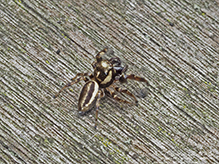 |
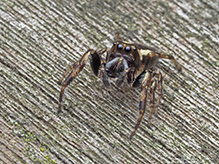 |
||||
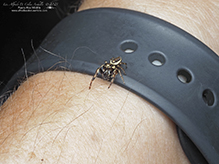 |
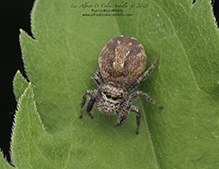 |
||||
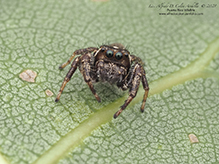 |
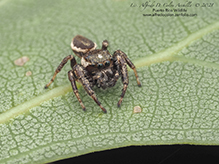 |
||||
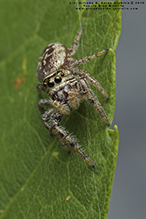 |
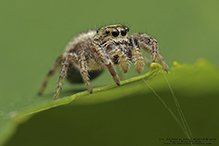 |
||||
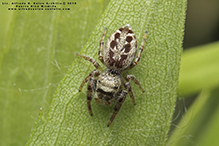 |
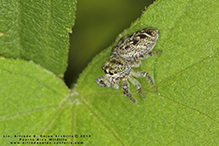 |
||||
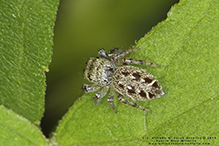 |
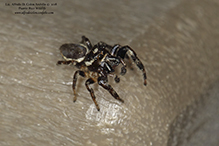 |
||||
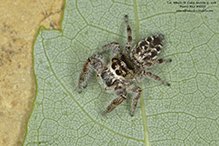 |
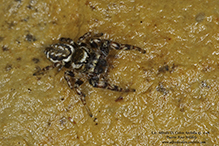 |
||||
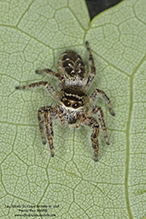 |
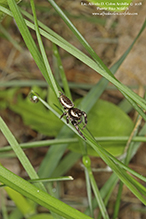 |
||||
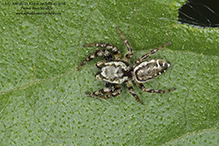 |
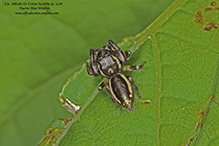 |
||||
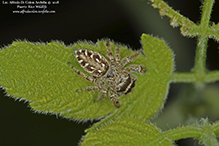 |
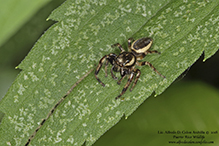 |
||||
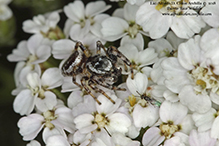 |
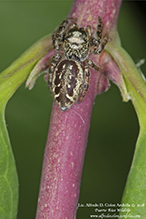 |
||||
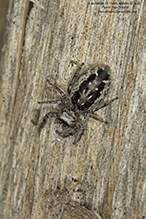 |
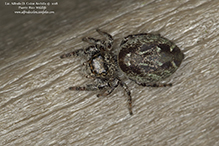 |
||||
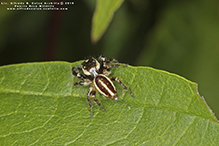 |
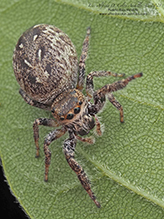 |
||||
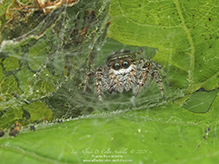 |
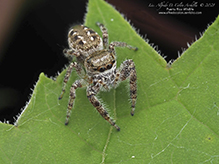 |
||||
Babette Kis |
|||||
Barnes Prairie, Racine Co., WI Eris militaris, bronze jumper, Barnes Prairie, Racine Co., WI. |
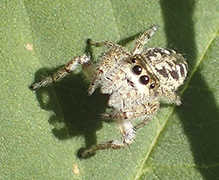 |
||||
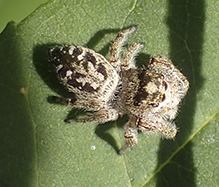 |
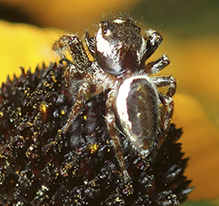 |
||||
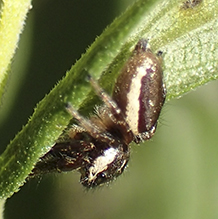 |
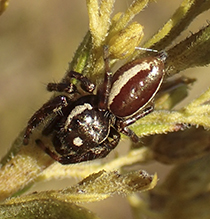 |
||||
MinnesotaSeasons.com Photos |
|||||
|
|||||

Slideshows |
||

Visitor Videos |
|||
Share your video of this arachnid. |
|||
| This button not working for you? Simply email us at info@MinnesotaSeasons.com. Attach a video, a YouTube link, or a cloud storage link. |
|||
Other Videos |
|||
| Eris militaris (Hentz, 1845) Middlesex Co., MA ♂ ♀ Dick Walton |
|||
About
Published on Nov 25, 2010 For narrative account, additional data, and usage see: http://www.rkwalton.com/salticids/Eris_militaris.php |
|||
| Bronze Jumping Spider (Salticidae: Eris militaris) Male on Leaf Carl Barrentine |
|||
About
Published on Jun 7, 2011 A nice long look at a handsome salticid spider. Note the ants on the plant's stem in the background. Photographed at the Turtle River State Park, North Dakota (06 June 2011). |
|||
| Eris militaris?- Bronze Jumper TheTyro |
|||
About
Published on May 7, 2010 I think she's a mature adult. Found her hiding inside a tulip. :D She's a cute little thing. Unfortunately I injured her while filming and she ended up losing a leg. She's fine though. I included footage where you can see a drop of her blood-hemocyanin-it's got a goldish coloration I think because it was in the sun-on her leg. |
|||
| Bronze Jumper (Salticidae: Eris militaris?) Male Carl Barrentine |
|||
About
Published on May 13, 2012 Photographed at the Turtle River State Park, North Dakota (13 May 2012). |
|||


Created: 7/25/2019
Last Updated:
